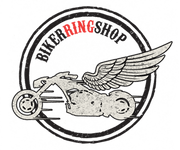"Necklaces are for women!"
Uh, no. Necklaces aren't just for women. Men can wear them, too.
In fact, men have adorned themselves with necklaces, neck wrappings, and other types of jewelry for centuries. The notion that men can't wear jewelry because it's for women is actually a recent concept.
The wearing of men's necklaces and other men's jewelry dates back several thousands of years.
Before Jewelry Was Jewelry
Back before we had store racks and glass cases, body decoration was found in nature. Researchers theorize that jewelry started off as flowers, leaves, animal bones and other common, lightweight objects. People would likely adorn themselves with these objects as a form of decoration.
It's All Greek
In Ancient Greece, people would wear wreaths on their heads and garlands around their shoulders. Typically, the flowers and leaves featured in their "jewelry" represented a god. For example, worshipers of the god of wine, Dionysus, often wore grapevines.
Moreover, this type of "jewelry" was used to denote military ranking as well as wealth and power.
The Celts Made Metal Men's Necklaces
The first true men's necklaces were produced by the Celts.
The Celts, who ruled Ireland, were master metal craftsmen. When it became popular to fashion jewelry out of metal, the Celts made ornate jewelry and armor out of gold and silver. Men, women—it made no difference who wore what in terms of these finely crafted pieces.
One piece of Celtic fashion, in particular, was called a torc. A torc is a metal semi-circle worn around the neck with the open area facing forward. It can be considered the first men's necklace of sorts.
Another piece of note was the lunula. It was shaped much like a torc, only it hung lower and tapered off towards the back of the neck. Again, it's another one of the early men's necklaces.
As with the Greeks, the Celts wore jewelry to denote power, wealth, and status.
In the Middle Ages
The Middle Ages marks the start of differentiation between men's and women's jewelry. However, that trend swung in favor of men.
As during the times of the Greeks and Celts, jewelry was used to show off wealth and power. Men wore crowns, scepters, brooches, and the like. Gemstones were used to adorn jewelry.
The Middle Ages saw the rise of stylized jewelry. Rings bore the seal of the family or house you were loyal to.
Additionally, the type of metal jewelry you wore spoke to your class. The upper class enjoyed gold and silver while the lower class settled for bronze and copper.
The Beginning of the Modern Age
From the Middle Ages and on, jewelry became even more stylized. Instead of gemstones being polished like before, they were now cut.
Jewelry also became more intricate as designers began to use the available tools to make animals, family crests, and other symbols into pendants, rings, and the like.
Designers also looked to past trends—to Roman, Greek, and other cultures—for inspiration for what stories to tell in the jewelry that they made.
The Industrial Revolution made jewelry more affordable, so people of all classes could show off their love for gold, silver, and other precious jewelry material.
From then on, the focus moved from looking to the past to looking to the future—to exploring interesting shapes and inventing new ones. This is a trend that continues on into today.
So Where Do Men's Necklaces And Other Jewelry Stand In All Of This?
The acceptability of men's necklaces and other men's jewelry various depending on culture. For example, Japan, India, and other countries have no problem with men showing off their love for precious adornments. Western countries tend to adopt the "jewelry is for women" attitude.
But that isn't to say that Western civilizations have not adopted any sort of men's necklaces and other jewelry as "common fashion" since the Middle Ages.
In fact, there are quite a few examples.
The '60s and '70s
Ah, the '60s and '70s—a time of peace, love, and revolution among America's youth. Teenagers and young adults who embraced the counterculture were branded as "hippies." And hippies had their own sense of fashion.
Hippie women wore pants, and hippie men grew their hair long. In addition, hippie women and men both wore "love beads," bracelets and necklaces made of colorful beads.
The trend of men wearing necklaces transcended hippie culture and made its way onto the disco scene of the '70s. Even though men wearing necklaces isn't popular, it became acceptable thanks to the hippie movement.
Modern-Day Rap and Hip-Hop Culture
Snoop Dogg, 50 Cent, the Notorious B.I.G., Tupac—it's hard to find a popular rap/hip-hop artist who hasn't worn a necklace at least once.
Around the turn of the century, it became fashionable for newly wealthy African-American men to don chains. These chains, which are gold or platinum, are worn around the neck as a necklace. At the end typically hangs a large, gem-encrusted pendant.
Religious Expression
A popular type of jewelry for both women and men is jewelry that expresses religious beliefs.
As such, necklaces with charms in the shape of the Christian cross, Jewish Star of David, and other religious motifs are common pieces of men's jewelry. Sometimes they are even gifted during christenings and other religious events.
Additionally, holy men are known for wearing pendants and other articles of jewelry that celebrate their faith. For example, it's rare you'll find a Catholic priest without his rosary beads.
Biker Culture
Chains, studs, buckles--biker fashion is all about metal. As such, it's common to find bikers (female and male) who don as much jewelry as they do black leather.
Popular choices for male biker jewelry include chain necklaces, bracelets, and skull rings.
The Best in Biker Fashion
Bikerringshop is the definitive shop for edgy, trendy biker fashion. We go out of our way to ensure our customers receive only the most stylish, high-quality pieces of biker jewelry around.

